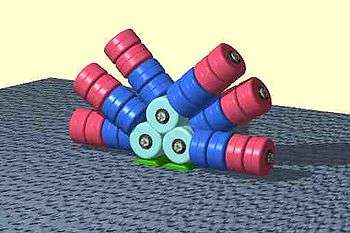Light-harvesting complex
A light-harvesting complex is a complex of subunit proteins that may be part of a larger supercomplex of a photosystem, the functional unit in photosynthesis. It is used by plants and photosynthetic bacteria to collect more of the incoming light than would be captured by the photosynthetic reaction center alone. Light-harvesting complexes are found in a wide variety among the different photosynthetic species. The complexes consist of proteins and photosynthetic pigments and surround a photosynthetic reaction center to focus energy, attained from photons absorbed by the pigment, toward the reaction center using Förster resonance energy transfer.
The function of a light-harvesting complex
Absorption of a photon by a molecule can lead to electronic excitation when the energy of the captured photon matches that of an electronic transition. The fate of such excitation can be a return to the ground state or another electronic state of the same molecule. When the excited molecule has a nearby neighbour molecule, the excitation energy may also be transferred, through electromagnetic interactions, from one molecule to another. This process is called resonance energy transfer, and the rate depends strongly on the distance between the energy donor and energy acceptor molecules. Light-harvesting complexes have their pigments specifically positioned to optimize these rates.
Light-harvesting complexes in bacteria
Light-harvesting complexes in plants
Chlorophylls and carotenoids are important in light-harvesting complexes present in plants. Chlorophyll b is almost identical to chlorophyll a except it has a formyl group in place of a methyl group. This small difference makes chlorophyll b absorb light with wavelengths between 400 and 500 nm more efficiently. Carotenoids are long linear organic molecules that have alternating single and double bonds along their length. Such molecules are called polyenes. Two examples of carotenoids are lycopene and β-carotene. These molecules also absorb light most efficiently in the 400 – 500 nm range. Due to their absorption region, carotenoids appear red and yellow and provide most of the red and yellow colours present in fruits and flowers.
The carotenoid molecules also serve a safeguarding function. Carotenoid molecules suppress damaging photochemical reactions, in particular those including oxygen, which exposure to sunlight can cause. Plants that lack carotenoid molecules quickly die upon exposure to oxygen and light.
Phycobilisome

Little light reaches algae that reside at a depth of one meter or more in seawater, as light is absorbed by seawater. A phycobilisome is a light-harvesting protein complex present in cyanobacteria, glaucocystophyta, and red algae and is structured like a real antenna. The pigments, such as phycocyanobilin and phycoerythrobilin, are the chromophores that bind through a covalent thioether bond to their apoproteins at cysteins residues. The apoprotein with its chromophore is called phycocyanin, phycoerythrin, and allophycocyanin, respectively. They often occur as hexamers of α and β subunits (α3β3)2. They enhance the amount and spectral window of light absorption and fill the "green gap", which occur in higher Plants.
The geometrical arrangement of a phycobilisome is very elegant and results in 95% efficiency of energy transfer. There is a central core of allophycocyanin, which sits above a photosynthetic reaction center. There are phycocyanin and phycoerythrin subunits that radiate out from this center like thin tubes. This increases the surface area of the absorbing section and helps focus and concentrate light energy down into the reaction center to a Chlorophyll. The energy transfer from excited electrons absorbed by pigments in the phycoerythrin subunits at the periphery of these antennas appears at the reaction center in less than 100 ps.
See also
- Photosynthesis
- Photosynthetic reaction center
- Photosystem II light-harvesting protein
- Light harvesting pigment
Further reading
- Caffarri (2009)Functional architecture of higher plantphotosystem II supercomplexes. The EMBO Journal 28: 3052–3063
- Govindjee & Shevela (2011) Adventures with cyanobacteria: a personal perspective. Frontiers in Plant Science.
- Liu et al. (2004) Crystal structure of spinach major light-harvesting complex at 2.72A° resolution. Nature 428: 287–292.
- Lokstein (1994)The role of light-harvesting complex II energy dissipation: an in-vivo fluorescence in excess excitation study on the origin of high-energy quenching. J. of Photochemistry and Photobiology 26: 175-184
- MacColl (1998) Cyanobacterial Phycobilisomes. JOURNAL OF STRUCTURAL BIOLOGY 124(2-3): 311-34.
External links
- UMich Orientation of Proteins in Membranes families/superfamily-2 - Calculated spatial positions of light harvesting complexes in membrane
- Light-harvesting protein complexes at the US National Library of Medicine Medical Subject Headings (MeSH)
- http://www.life.illinois.edu/govindjee/photoweb - Photosynthesis and all sub categories